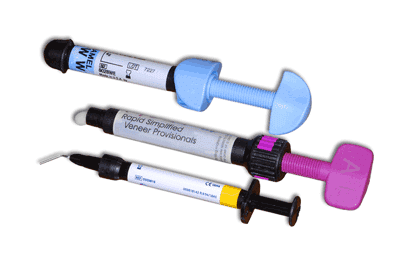Dental bonding is a technique dentists frequently employ to enhance the aesthetic appeal of teeth affected by decay, cavities, or damage. Typically, bonding targets specific areas of a tooth, such as chips or cracks, in contrast to veneers, which encompass the entire front surface. Bonding utilizes composite resin to enhance the aesthetic appeal of teeth.
This treatment option proves notably swifter and more cost-effective for addressing minor cosmetic imperfections.
The bonding material, a putty-like composite resin, is meticulously selected to harmonize with the natural color of the patient's teeth.
A specialized blue curing light is employed after the composite resin is applied to the tooth surface. This distinctive light is pivotal in solidifying the composite resin and establishing a solid bond with the tooth.
An imperative aspect of this process involves the dentist's skill in selecting the appropriate composite color. Seasoned cosmetic dentists employ a layering technique using multicolored composites, mimicking real teeth' natural and translucent appearance.


Durability of Tooth Bonding
The longevity of tooth bonding is contingent upon several factors, including the specific tooth treated, individual bite characteristics, and dietary habits.
Dental bonding on the front teeth's surface typically lasts 3 to 8 years. However, the composite resin employed in this procedure is less durable than natural teeth. Vulnerabilities arise when the bonding is close to the tooth's edge, mainly when contact with other teeth occurs during biting or when consuming hard foods. The composite material may chip or separate from the natural tooth.
Additionally, it is noteworthy that composites tend to stain more readily than natural teeth, necessitating regular attention to maintain the aesthetic integrity of the bonding.

Choosing Between Dental Bonding and Veneers
The decision between dental bonding and veneers involves careful consideration of various factors. Each option offers distinct advantages.
Dental Bonding (Composites):
Composites, or direct bonding, demand meticulous technique particularly when aiming for a natural appearance. The layered composite application process requires extended chair time to achieve optimal cosmetic results, making it suitable for single-tooth restoration and smaller areas.
Ideal candidates for bonding include individuals with improper gum positions and children whose teeth are still erupting. Veneers are generally deferred for children due to their evolving gum line, which could prematurely expose the margin of the veneers.
We recommend dental bonding as an initial step to simulate final results before proceeding with veneers. This simulation enables patients to visualize the anticipated cosmetic outcome in the context of their mouth and facial features. Additionally, it allows us to assess functional aspects and address any issues before finalizing the veneer design.
Porcelain Veneers:
We strongly recommend porcelain veneers over composite bonding for those seeking a comprehensive smile makeover involving 4, 8, or 10 veneers. Veneers offer extended durability, resistance to staining, and the ability to impart a natural, translucent appearance. They also afford the flexibility to alter the size and angle of each tooth, achieving a straighter overall look.
By opting for veneers, patients benefit from a longer-lasting solution with enduring cosmetic results. Testing the functional outcome during the initial bonding phase is crucial to avoid potential issues with the final veneers. Doing so can address concerns promptly, ensuring the longevity and success of your veneer application.
In summary, while dental bonding is a valuable tool, especially for specific cases, veneers emerge as the preferred choice for those seeking a comprehensive smile transformation with lasting aesthetic and functional benefits.



